Nicol McKechnie's voyages, 1869 to 1877
These details were taken from original discharge certificates, supplemented by researching in the Caird Library of the National Maritime Museum in Greenwich, and other sources.
The discharge certificate was issued by the port shipping officer on behalf of the board of trade. As well as giving name and personal details of the seaman and details of the ship and voyage, on the reverse it gave an appraisal ("very good", "good", or "declines to report") on "ability in whatever capacity engaged", and in "conduct". I am pleased to report that on all voyages, Nicol McKechnie was marked "very good" on both counts.
Stella to Cuba, 1869
Ship |
||||
Name |
Reg. number |
Reg. Port |
Reg. tonnage |
Engine hp |
Stella |
15435 |
Greenock |
213 |
- |
Voyage |
||||
Date of Engagement |
Place of Engagement |
Date of Discharge |
Place of Discharge |
Capacity |
5 May 1869 |
Greenock |
8 Aug 1869 |
Greenock |
Carpenter Seaman |
Destination |
Matanzas (Cuba) | |||
| Cargo | Back: probably raw sugar | |||
| Master: | John Torrance | |||
At the age of 24, on 5th May 1869 Nicol McKechnie was engaged as carpenter for a voyage to Cuba on the wooden barque 'Stella', and on the 7th May she sailed under the command of John Torrance. She called at Queenstown in south-eastern Ireland (now called Cobh, pronounced 'cove'), sailing from there on the 4th June. Her departure was reported to London at 10.45am on the same day by the new 'Marine Telegraph' system, which used telegraph wires and possibly a cable under the Irish sea to carry morse coded messages.
After arrival at Matanzas, one of the main sugar-exporting ports of Cuba, 'Stella' would have discharged any general cargo she was carrying and loaded her return cargo, which would almost cetainly have been sacks of unrefined sugar for processing in one of Greenock's many sugar refineries. She sailed again on 8th July, arriving off Queenstown on the 4th August. Nicol was discharged on 8th August following her return to Greenock.
Lord Palmerston to Mauritius, 1869-70
Ship |
||||
Name |
Reg. number |
Reg. Port |
Reg. tonnage |
Engine hp |
Lord Palmerston |
16245 |
Glasgow |
649 |
- |
Voyage |
||||
Date of Engagement |
Place of Engagement |
Date of Discharge |
Place of Discharge |
Capacity |
16/11/1869 |
Glasgow |
8/6/1870 |
Greenock |
Carpenter |
Destination |
Mauritius | |||
| Cargo | Back: probably raw sugar | |||
| Master: | P. Ferguson | |||
Nicol McKechnie was engaged on 16th November 1869 for a voyage on the wooden-hulled ship 'Lord Palmerston' under Captain Ferguson. She sailed from Greenock for Mauritius on 20th November, and on 21st December she was reported at 4N 24W, which is mid-atlantic at the latitude of Northern Brazil. On 11th February 1870 she arrived in Mauritius, where she would have unloaded any outward cargo before loading the return cargo, probably sacks of unrefined sugar. She sailed for home on 16th March, and arrived back in Greenock on 7th June. Nicol was discharged the next day.
City of Halifax to Newfoundland, 1873
Ship |
||||
Name |
Reg. number |
Reg. Port |
Reg. tonnage |
Engine hp |
City of Halifax |
58954 |
Liverpool |
463 |
120 |
Voyage |
||||
Date of Engagement |
Place of Engagement |
Date of Discharge |
Place of Discharge |
Capacity |
21/1/1873 |
Greenock |
9/5/1873 |
Greenock |
Carpenter |
Destination |
St John's, Newfoundland | |||
| Cargo | Out: possibly coal and general cargo. Back: seal skins | |||
| Master: | W. A. Jackman | |||
Nicol McKechnie was engaged on 21st January 1873 for a voyage on the screw steamer 'City of Halifax' under the command of captain W. A. Jackman. 'City of Halifax' was one of a number of ships specially built for seal fishing, and was of similar design and construction to the whalers of the same era. At that time, it was thought that only a massively thick wooden hull could wihstand the stresses of work in the ice. They were fully rigged as sailing ships so that they could approach their quarry quietly using sail. Steam power was required for working among the ice floes, or to supplement the sails on ocean voyages. These steam sealers were the last merchant ships to carry the masts and yards of sailing vessels, and the last of them were still working in the late 1930s.
'City of Halifax' sailed from Ardrossan for Newfoundland on 25th January 1873, and arrived at St. John's on 10th February. On 11th February she was damaged by fire, but was repaired. On 1st April, the 'Cape Breton Advocate' of Halifax, Nova Scotia, reported on the Newfoundland seal fishery, and 'City of Halifax' was said to be in Bonavista Bay along with numerous other ships, loaded with 6000 seals.
On 10th April, 'City of Halifax' sailed from St. John's, and arrived back in the Clyde on 10th May 1873 to a gentle westerly wind and a rising barometer. Nicol's discharge was dated the same day.
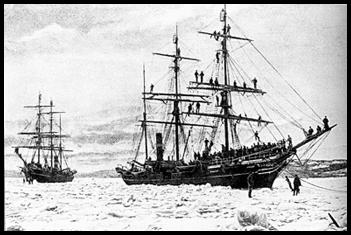 |
 |
| Steam ships similar to 'City of Halifax' in the Newfoundland seal fisheries during the 1860s or 70s. These ships had thick wooden hulls to resist the ice, and were still in use in the 1930s. | The steam ship 'Aurora' in port, probably at St John's, Newfoundland. Many years later, 'Aurora' was a support ship for Shackleton's ill-fated expedition to the Antarctic. |
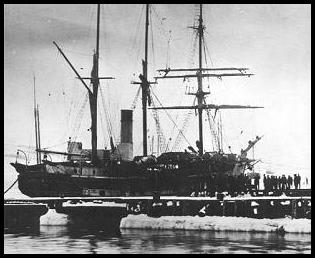 |
||
| The steamer 'Iceland' discharging seal pelts at Harbour Grace, Newfoundland. 'Iceland' was in Bonavista Bay with 'City of Halifax' in the spring of 1873. |
Dunloe to India, 1874-75
Ship |
||||
Name |
Reg. number |
Reg. Port |
Reg. tonnage |
Engine hp |
Dunloe |
63445 |
Greenock |
674 |
|
Voyage |
||||
Date of Engagement |
Place of Engagement |
Date of Discharge |
Place of Discharge |
Capacity |
31/7/1874 |
Liverpool |
28/6/1875 |
Greenock |
Carpenter |
Destination |
Calcutta and Trinidad. | |||
| Cargo | ||||
| Master: | James Burns | |||
Nicol McKechnie was engaged on 31st July 1874 for a voyage on the iron-hulled ship 'Dunloe' under the command of James Burns. She sailed from Liverpool for Calcutta on 5th August. On 15th September she was reported arriving at Rio de Janiero, and on 5th December she arrived in Calcutta. She sailed again on 18th January 1875, this time bound for Trinidad, where she arrived on 1st May. She arrived back on the Clyde on 28th June, and Nicol's discharge was dated the same day.
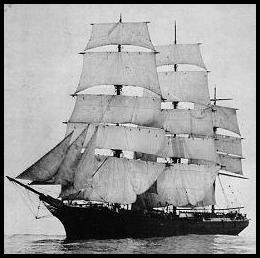 |
||
| The full-rigged ship 'Torrens' photographed in the late 19th century. 'Dunloe' was similar to this in rig and general appearance. |
Ardvar to Auckland and San Francisco, 1875-77
Ship |
||||
Name |
Reg. number |
Reg. Port |
Reg. tonnage |
Engine hp |
Ardvar |
72399 |
Greenock |
857 |
- |
Voyage |
||||
Date of Engagement |
Place of Engagement |
Date of Discharge |
Place of Discharge |
Capacity |
19/10/1875 |
Glasgow |
1/2/1877 |
Dublin |
Carpenter |
Destination |
Auckland (N.Z.), San Francisco | |||
| Cargo | 5 passengers to Auckland | |||
| Master: | James Burns | |||
Ardvar was built at Duncan's shipyard in Port Glasgow, and completed in September 1875. She was built of iron with a length of 197 ft, a beam of 32 ft and a registered tonnage of 858 tons. She was rigged as a barque, ie fore and main masts square-rigged, mizzen mast fore-and-aft rigged.
Nicol McKechnie was engaged on 19th October 1875 as carpenter for Ardvar's maiden voyage. On 25th October she departed the Clyde bound for Auckland, New Zealand, under the command of James Burns. Her cargo is not known, but she carried 5 passengers for Auckland; John Clark (22), David Dobie (25), William Graham (17), James Kay (39), and G McInder. She was noted on 25th November standing on a southerly course at 8N, 25W, which is mid-Atlantic between Africa and northern Brazil. On 16th February 1876 she arrived at Auckland, where she would have discharged her passengers.
About 10th June, Ardvar was reported at 4N, 122W, about half way between New Zealand and San Francisco. The next report was not then until 28th January 1877, when she arrived in Queenstown, SE Ireland (now renamed Cobh) "with the loss of a jib boom". She sailed into Dublin on 8th February, and Nicol was discharged the next day, presumably returning home to Greenock by ferry or coaster.
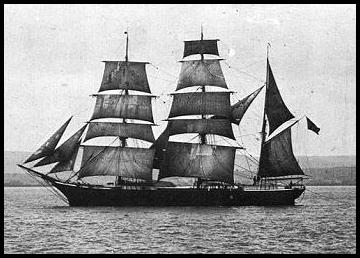 |
||
| The barque 'Asta' outbound from the Bristol Channel. 'Ardvar' would have been similar to this in rig and general appearance. |
![]()
Life on Board
The following pictures provide a general feel for life on board a sailing vessel in the second half of the 19th century.
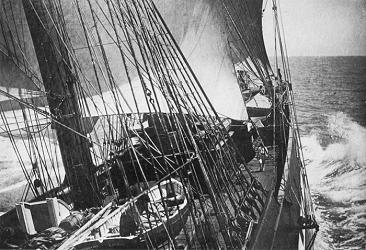 |
||
| A full-rigged ship braced up on the starboard tack in a smooth sea. A passenger strolls on the main deck and a seaman is cleaning out one of the boats. These are ideal sailing conditions. |
![]()
View reverse of a discharge certificate
![]()
![]()
References
Some of the information and photographs reproduced above are from the following sources:
Victorian and Edwardian Sailing Ships from Old Photographs, Basil Greenhill & Ann Giffard, Batsford, London, 1976.
Victorian and Edwardian Merchant Steamships from Old Photographs, Basil Greenhill & Ann Giffard, Batsford, London, 1979.
![]()
Updated 22-12-00